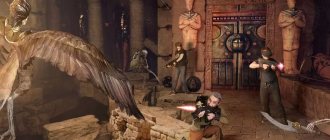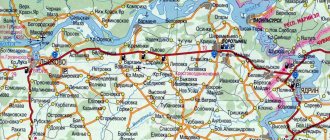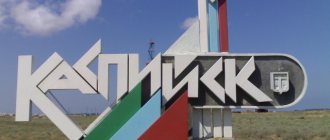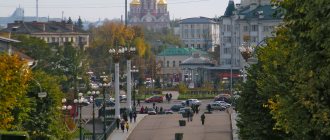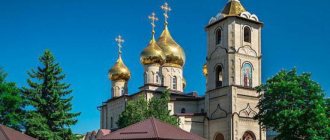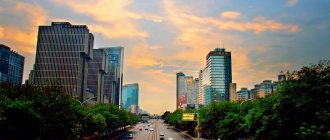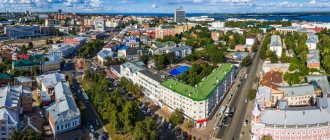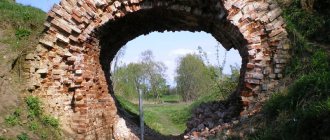Kostroma is an ancient city on the Volga, founded in the 12th century by the Kyiv prince Yuri Dolgoruky.
According to legend, once upon a time a dense, impenetrable forest grew in this place, with “kostrubata” - crooked and gnarled dry trees. Dolgoruky ordered this forest to be burned, and in its place he founded a city. Soon people began to settle near the princely fortified place and the city began to grow.
How to get to Kostroma from Moscow - an overview of methods and useful services.
- From Kostroma you should definitely stop by Yaroslavl - a little over an hour by car.
- The most interesting places in the Kostroma region and neighboring Yaroslavl region for those planning a route.
- We wrote in detail about other nearby and worth visiting cities of the Golden Ring here.
Susaninskaya Square
This is one of the favorite places of the townspeople and one of the most interesting. Its “folk” name is Frying Pan. It is probably connected with the external similarity of the area of this dish: seven streets radiate from it, each of them could be a handle.
Some people see similarities with a fan; there is also a legend here: when Catherine II was asked what the square should look like, she smiled mysteriously and dropped the fan on the map.
Once upon a time, the Sula River flowed here, and on a hill stood a wooden fortress. Lightning set it on fire, a huge fire broke out, the fortress and other buildings burned to the ground. Nothing was restored; the fortress had long ago lost its strategic importance; it was decided to create a square in its place. For this purpose, the river was hidden underground.
There are many historical interesting buildings on the square: shopping arcades, public places, and today the city administration building, the public meeting building, Borshchov's house.
Borschov's House
Address: st. Shagova, 1 (facade facing Susaninskaya Square)
This estate is one of the largest in the city of the early 19th century. Built in the Empire style, decorated with a portico with eight Corinthian columns.
Nekrasov stayed here, from here he observed the life of the city, from here the now defunct monument to Tsar Mikhail and Susanin was best seen. And it was in this house that the poem “Who Lives Well in Rus'” was written.
Shopping arcades
Built simultaneously with the square, they have been preserved in their original form to this day. In the 18th century, traders from the East and West came here along the Volga.
There were previously other wooden shopping arcades here, but during one of the fires they burned to the ground. After this fire, a general reconstruction of the city began, at the same time Sulu was removed underground, and city buildings began to be made of stone.
What was new was that each trader was given space and one standard-size shop, and that trade was divided by industry.
Construction began with the Red Rows, the largest. They are also called Gostiny Dvor. There were also Flour and Petty rows and many others. The shape of the rows is interesting - it is a rectangle with rounded corners.
Trade continues here today, so to get a better look at them, you should come here in the morning, when there are no traders or buyers.
There are also many pigeons living in the square. According to an old legend, city pigeons are the souls of the soldiers who defended this city. Pour cereal or seeds into your palm and pull it forward - they will fly off and peck right from your hand.
There are many interesting installations on the square - a sculpture of the Snow Maiden, a Sundial, and a monument to the fire dog Bobka.
Fire Tower
A fire tower is not just a “pillar in the square.” A tall structure, built in the Empire style in 1825, about 35 meters high - this is exactly what was needed to see a fire starting somewhere and give a sign.
From that time and throughout the 19th century, the tower faithfully served the city. It was recognized as the best watchtower in the Russian province. It had a fire station, office premises for employees, stables, water barrels, and when cars appeared, then garages.
The tower itself is most similar to the bell tower of temples, it is so large and majestic, and its facade looks like a palace with an Ionic colonnade on the portico. Since the development of telephony, the tower has lost its original purpose; now it houses the Kostroma Museum-Reserve.
Monument to the dog Bobka
The heroic dog Bobka carefully watches to see if there is trouble anywhere - back at the beginning of the last century, he became famous for actively helping firefighters, entering smoky rooms and helping those who were in them to get out, even if it was a pet huddled under the bed.
Everyone in the city knew Bobka, loved and appreciated him, and when he died, they mourned him as a real hero and buried him with honors.
In 2006, a life-size monument was erected to him. Next to him is his favorite ball toy, now it’s a piggy bank - all the money raised goes to help an animal shelter.
Cheese exchange in Kostroma
Kostroma Cheese Exchange
The Cheese Exchange is located to the left of the square, in Bolshie Flour Rows, pavilion No. 53
In the political sense, Kostroma was not called the capital for long, but to this day it has proudly carried the title of the cheese capital.
At the end of the 19th century, in the village of Andreevskoye, merchant Vladimir Blandov founded the first cheese factory on Kostroma soil. In those days, cheese was a rare and expensive delicacy and it was rarely available to ordinary commoners. But after some time they began to produce it on an industrial scale throughout Russia.
Cheese production on the map of Kostroma province
Today in the Kostroma region there are about 11 large cheese production facilities that produce the famous varieties “Kostromskoy”, “Susaninsky”, “Demidov”, “Voskresensky”, “Ivan Kupala”.
Kostroma cheese
If you are in Kostroma, be sure to check out the Cheese Exchange, which is located on Susaninskaya Square on the Volga side. Here you can try the whole variety of Kostroma cheeses, and buy the product you like at the manufacturer’s price.
Monument to Ivan Susanin
Address: across the road from Susaninskaya Square, facing the Volga
The monument was erected in Kostroma in September 1967. The author is sculptor Nikita Lavinsky.
Despite the apparent simplicity, extraordinary strength of spirit is felt in Susanin’s entire appearance. There is a monument on the site where the Alexander Nevsky Chapel once stood.
It should be noted that this is not the first monument to the hero. Before him, there was already one in Kostroma, destroyed under Soviet rule, in which not so much Susanin was immortalized as the young Tsar Mikhail.
Monument to Yuri Dolgoruky
Address: Voskresenskaya (Sovetskaya) square
The monument was erected in honor of the 850th anniversary of the founding of the city. This is a large bronze sculpture more than 4 meters high, standing on Resurrection Square. At its base is a capsule with soil from the burial place of the prince, the Kiev Pechersk Lavra complex, and the Church of the Savior on Berestov.
The monument depicts the prince sitting on a throne wearing a Monomakh hat and holding a sword in his hand. The four-ton sculpture was unveiled on August 29, 2002, the day of the Icon of the Feodorovskaya Mother of God, patroness of Kostroma.
Churches and monasteries
Ipatiev Monastery
Address: st. Enlightenment, 1 Website: https://ipatievsky-monastery.ru/ Reception phone number: Pilgrimage department (excursions): (4942) 31-25-89 Opening hours: from 10.00 to 17.00
The monastery is located at the confluence of the Kostroma and Volga rivers, surrounded by mighty fortress walls. Once he occupied a strategic position, he was patronized by the Romanovs and the Godunov boyars.
It so happened that the Ipatiev Monastery became the refuge of the first Tsar of Russia, where young Mikhail Romanov was elevated to the throne.
It is not known for certain when the monastery was founded. Chronicles mention it from the middle of the 15th century, but there is every reason to believe that the first wooden buildings were here already in the 13th century.
The main building of the monastery is the five-domed Trinity Cathedral. Its interior is richly painted with frescoes, and there is also a shrine - the miraculous icon of the Tikhvin Mother of God.
On the territory of the monastery there are the Church Historical and Archaeological Museum and the Museum of the Chambers of the Romanov Boyars .
There is also a museum of wooden architecture . This is an open-air museum, opened in 1958. Then the most valuable remaining wooden buildings - huts, churches and the like - were brought to the center from the entire region. In Kostroma itself, samples of wooden architecture were not preserved due to fires. What they managed to collect, the restorers put it in order, made it into a museum, and now everyone can see how people lived in past centuries.
In 2004, it was solemnly transferred to the Russian Orthodox Church.
Epiphany-Anastasia Monastery
Address: st. Simanovsky, 26 Phone:
A pearl of Russian architecture, built in the Russian Baroque style.
This is an active convent, founded in 1426 by Nikita Kostromsky, a student of Sergei of Radonezh. At first, all the buildings were wooden, and only in the middle of the 16th century the first stone Epiphany Cathedral appeared.
In the 17th century, despite the Time of Troubles, buildings continued to be erected in the monastery - residential and utility buildings, churches.
In the middle of the 19th century, there was a severe fire in the city, the monastery was almost dismantled, and only the protests of the townspeople helped it survive.
Church of the Resurrection on Debra
Address: st. Nizhnyaya Debra, 37 Phone:
The church is located on an old place of worship - Nizhnyaya Debra. Wooden churches were constantly erected here. But due to frequent fires, they did not last long.
A stone temple was erected here in 1623-1645, and it was one of the first stone buildings in Kostroma - until the mid-18th century it remained almost entirely wooden. At that time, the temple was luxurious and very large - a three-apse, five-domed cathedral. The temple was painted by famous masters of that time - an artel led by V.I. Zapokrovsky.
The money for construction was given by the Kostroma merchant Isakov. According to legend, he bought several barrels of paint in England. One of them contained gold. The God-fearing man considered this an order from above and donated the barrel to the city treasury - to the temple. Since the wooden church had burned down shortly before, it was decided to build a stone one in its place. And Isakov himself went down in the history of the city as a philanthropist.
The church miraculously survived in the 1930s and was returned to the Russian Orthodox Church in June 1946.
Women must have a headscarf and preferably wear a skirt.
Bird's eye view of the city
Modern author's photography using balloons or copters allows you to see and capture a familiar city from unusually new angles.
Fan of the central streets of the night city.
Photo by A. Voinov,
2019. Illumination of the city at night. Photo by
A. Voinov
, 2019. City streets at night from above.
High-aperture photo-video equipment allows us to examine the theme of lanterns in night scenes in more detail.
Ice.
sculptures on Susaninskaya Square. Moon over the city. A. Voinov
Bridge over the river
Kostroma. A. Voinov
Mouth of the Kostroma River
A. Unknown
2020
Mountain street.
Photo by A. Voinov
Central Park.
A. Voinov
View from the bell tower of the Elias Church.
A. Unknown
We have the opportunity to see historical sights on different planes and in their natural surroundings thanks to the ability of drones to change the position of the camera in space in relation to the subject of photography.
Central square.
A. Voinov
Evening streets in the light of lanterns 2022
A. Voinov
Susaninsky Square in the light of lanterns in the evening 2022
A. Voinov
Red rows.
A. Voinov
Susaninskaya Square.
A. Voinov
“Golden Ring of Russia” AirPano.com City center.
The pioneer in publishing three-dimensional images of the city of Kostroma, captured from aircraft, was the site AirPano.com. We used some of the autumn wide-angle photographs to demonstrate the true professionalism of aerial photography as part of our multimedia exhibition section.
AirPano.com The mouth of the Kostroma River.
AirPano.com Ipatiev Monastery. Left Coast. A. Voinov
Railway bridge in winter.
A. Voinov
Church in Selishche.
A. Unknown
Last snow.
A. Voinov
The Epiphany Cathedral being recreated by the builders.
A. Unknown
Construction of the bell tower of the Epiphany Cathedral.
A. Unknown
Lunar disk against the background of the bell tower.
A. Unknown
Railway Bridge.
A. Unknown
Bridges over the Volga.
A. Unknown
Ostrovsky's gazebo Airstrip in Sokerkino.
A. Unknown
AN-26 of the Kostroma Airlines on takeoff.
A. Unknown
Fanplate.
Loading wood. A. Unknown
View platform of the fire tower May holidays on the street.
Soviet. A. Voinov
Monument to the dear leader angle.
A. Voinov
Monument to Vladimir Ilyich against the background of the bridge.
A. Unknown
Lenin for the people at any time of the year (autumn).
A. Unknown
#Selfie #Monumentos #Photography #Russia Successful against the backdrop of sunset Photo by
A. Voinov
2019. Balloon over the Klyuchevka River.
A. Unknown
2021
The appearance of a metal sculpture of an extraordinary Leader in the epicenter of the cradle of the Romanov tsars reminds us of the history of the forced change of power in Russia.
Fire tower surrounded by birds
Photo
Timur Kostroma 2014
Central Park
It is located in the very center of the city, where the Kostroma Kremlin once was. This is a very beautiful and green place where you can just enjoy spending time. From May to mid-September there are attractions here, the alleys are well laid out and there are places to ride bicycles. There is also a spacious observation deck.
Observation deck and embankment
To see the city, just go up to the observation deck. From here you can see all the beauty of the river, landscapes, and the pier. Since Kostroma is one of the cities of the Golden Ring, cruise ships plying along the Volga moor at the pier.
On the embankment itself near the park there is a stylized ancient Russian boat.
The embankment is very wide and beautiful; on weekends it is a pedestrian zone and a place for festivities. This is one of the places in Kostroma where the film “Cruel Romance” was filmed.
The observation deck is located in the city park above the embankment. From here, along the longest linden alley in the city, you can walk to Ostrovsky’s new gazebo.
Ostrovsky's gazebo
It stands on a hill above the Volga, in the very place where Alexander Nikolaevich himself loved to come during his lifetime. The ancient Kostroma Kremlin once stood on this embankment, and now only archaeologists and historians can indicate where it was - time has destroyed even the foundation.
It is similar to the ancient gazebos that were usually built in past centuries in Russian estates; it looks very light and airy. It has seven columns of the Ionic order, and from here a stunning panorama of the Volga opens up.
Besedka is also one of the “actresses” in the film “Cruel Romance” based on Ostrovsky’s play “Dowry”. And the playwright wrote many of his plays in Kostroma, and many Kostroma places are easily recognizable in his plays. The grateful townspeople therefore named this gazebo after their fellow countryman Ostrovsky.
Cities through the eyes of residents: unobvious places in Kostroma
Natalya Shumilova
Kostroma is an ancient Russian city that still retains its authenticity. You should start getting acquainted with it from the Trade Rows - drink a cup of excellent coffee with the best croissants in the city at the Coffee Capella coffee shop.
Coffee Capella
Red Rows, 1
Sit at a table outside and enjoy the view of Tobacco and Green Rows.
View this post on Instagram
Posted by Coffee Capella (@capellacoffee)
View this post on Instagram
Publication from Unknown
